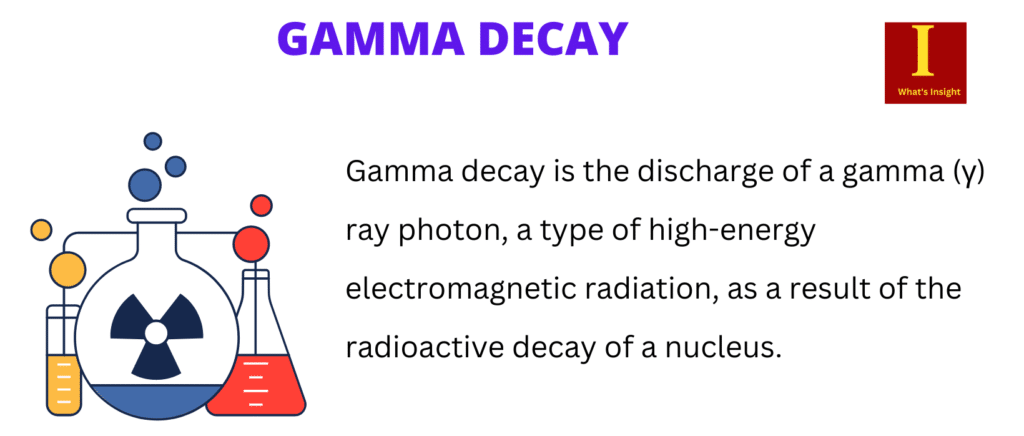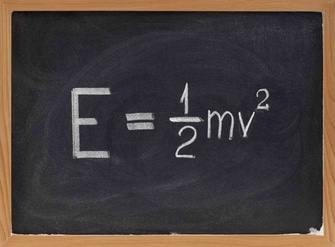Gamma decay is the discharge of a gamma (γ) ray photon, a type of high-energy electromagnetic radiation, as a result of the radioactive decay of a nucleus. The energy spectrum is often in the 100 keV to 10 MeV range. Furthermore, Gamma decay differs from alpha or beta decay in that no particles are expelled from the nucleus during this kind of decay. Instead, a high-energy kind of electromagnetic radiation – a gamma-ray photon – is emitted.

Table of Contents
Science Behind Gamma Decay
Gamma decay (γ-decay) is one of the three primary forms of radioactive decay. The energy of the parent atom is changed during gamma decay by the emission of a photon. The daughter atom’s resultant energy is lower than that of the parent atom. A photon is a massless particle with a very short wavelength.
In addition, Gamma rays are pure energy. They are comparable to visible light but significantly more energetic. During radioactive decay, gamma rays are frequently released with alpha or beta particles.
A nucleus must be in an exciting energetic state in order to undergo gamma decay. Experiments have revealed that if a proton or neutron inside the nucleus goes up to an excited state – often after alpha or beta decay – the new daughter nucleus must release energy to let the proton or neutron relax back down to the ground state. A gamma photon is released when a nucleon transitions from a high to a low energy state.
Furthermore, Gamma decay occurs when a nucleus is excited and has too much energy to be stable. This frequently occurs after alpha or beta decay has happened. Because gamma decay only emits energy, the number of protons remains constant.
Gamma-rays are the most energetic kind of light and are created by the universe’s hottest regions. They are also created by extreme events such as atom disintegration, as well as less spectacular occurrences such as radioactive decay in space. Celestial gamma-rays are produced when huge stars die, neutron stars and pulsars, and black holes.
Summary
- Gamma decay (γ-decay) is one of the three primary forms of radioactive decay.
- Gamma decay only emits energy, and the number of protons remains constant.
- After alpha and beta decay, when daughter nuclides attempt to transition from excited to ground states, they emit radiations.
Frequently Asked Questions
1. What happens to quarks in beta decay?
Beta-decay can transform a neutron (one up quark and two down quarks) into a proton (two up quarks and one down quark), an electron, and an electron antineutrino. This reaction can happen in the neutron of an atom or in a free-floating neutron.
2. What is microfarad to farad?
One microfarad is equal to 0.000001 farad.
3. What is a cathode electrode?
The cathode is the electrode that is negatively charged. Cations or positive charges are attracted to the cathode. The cathode is either an electron donor or a source of electrons. It is possible that it will accept a positive charge.
4. What is photonics?
Photonics is the study of light waves as a physical phenomenon. It is involved with the generation, detection, and manipulation of light. The dual nature of light is described by the wave-particle duality.
5. Does gamma decay release electromagnetic energy?
Gamma decay is a kind of radioactivity in which certain unstable atomic nuclei spontaneously discharge their surplus energy through an electromagnetic mechanism. Gamma rays (photons, or packets of electromagnetic energy, of extremely small wavelength) are emitted in the most frequent form of gamma decay, known as gamma emission.
Check another interesting article “What are electromagnets“.
6. What is Stress in physics?
Stress in physics is the measurement of an external force acting on an object’s cross-sectional area. Stress is measured in units of force per unit area, such as N/m2 (SI) or lb/in2 (US). Pascals, abbreviated Pa, are the SI units that are most widely used.
7. Define conduction in physics?
Conduction in physics refers to the transfer of energy through the movement of particles that are in contact with each other.
8. spring constant
The spring constant is a property of a spring that measures the relationship between the force acting on it and the displacement it causes. To put it another way, it indicates the stiffness of the spring and how much it will stretch or compress.
More Links
- BCl3 Lewis Structure in four simple steps - November 1, 2023
- PH3 Lewis Structure in four simple steps - October 8, 2023
- PF3 Lewis structure in four simple steps - September 24, 2023



